Operations and Service Management: Supply Chain Efficiency at TESCO
VerifiedAdded on 2023/06/10
|11
|3324
|220
Report
AI Summary
This report analyzes the operations and service management activities within TESCO, a prominent retail organization, focusing on best practices in operations management, including stock control, purchasing, information management, and quality standards. It examines the impacts of supply chain management (SCM) on organizational efficiency, such as improved output, returns management, supplier selection, metric tracking, profitability, competitive advantage, process standardization, historical process storage, employee engagement, continuous improvement, and technology leverage. The report further explores the potential use of technologies like IoT, advanced SCM software, cloud technology, AI, machine learning, and big data in enhancing TESCO's supply chain, aiming for sustainability, effectiveness, ethical responsibility, and better business growth. This analysis provides valuable insights into how TESCO can optimize its operations and supply chain to achieve greater efficiency and customer satisfaction.
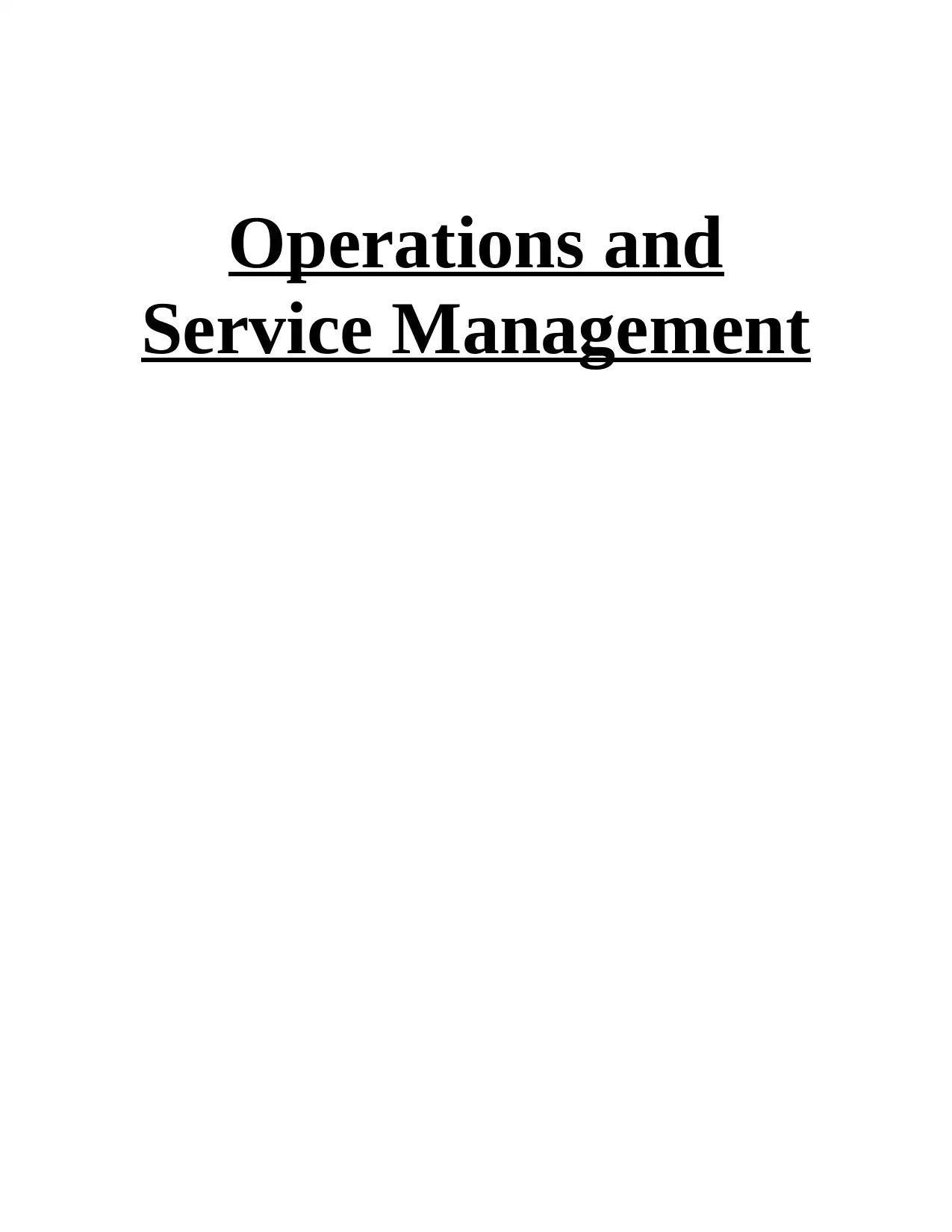
Operations and
Service Management
Service Management
Paraphrase This Document
Need a fresh take? Get an instant paraphrase of this document with our AI Paraphraser
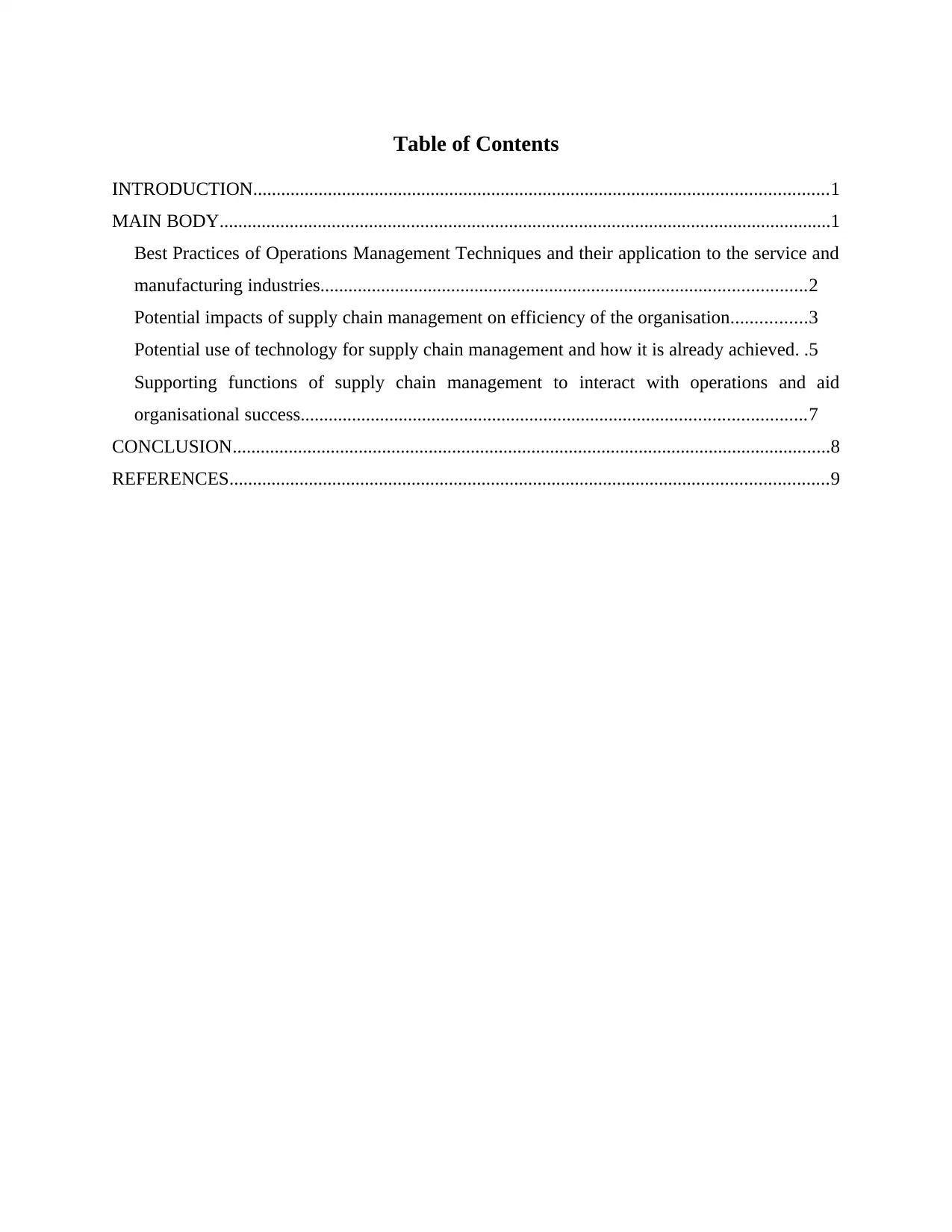
Table of Contents
INTRODUCTION...........................................................................................................................1
MAIN BODY...................................................................................................................................1
Best Practices of Operations Management Techniques and their application to the service and
manufacturing industries........................................................................................................2
Potential impacts of supply chain management on efficiency of the organisation................3
Potential use of technology for supply chain management and how it is already achieved. .5
Supporting functions of supply chain management to interact with operations and aid
organisational success............................................................................................................7
CONCLUSION................................................................................................................................8
REFERENCES................................................................................................................................9
INTRODUCTION...........................................................................................................................1
MAIN BODY...................................................................................................................................1
Best Practices of Operations Management Techniques and their application to the service and
manufacturing industries........................................................................................................2
Potential impacts of supply chain management on efficiency of the organisation................3
Potential use of technology for supply chain management and how it is already achieved. .5
Supporting functions of supply chain management to interact with operations and aid
organisational success............................................................................................................7
CONCLUSION................................................................................................................................8
REFERENCES................................................................................................................................9
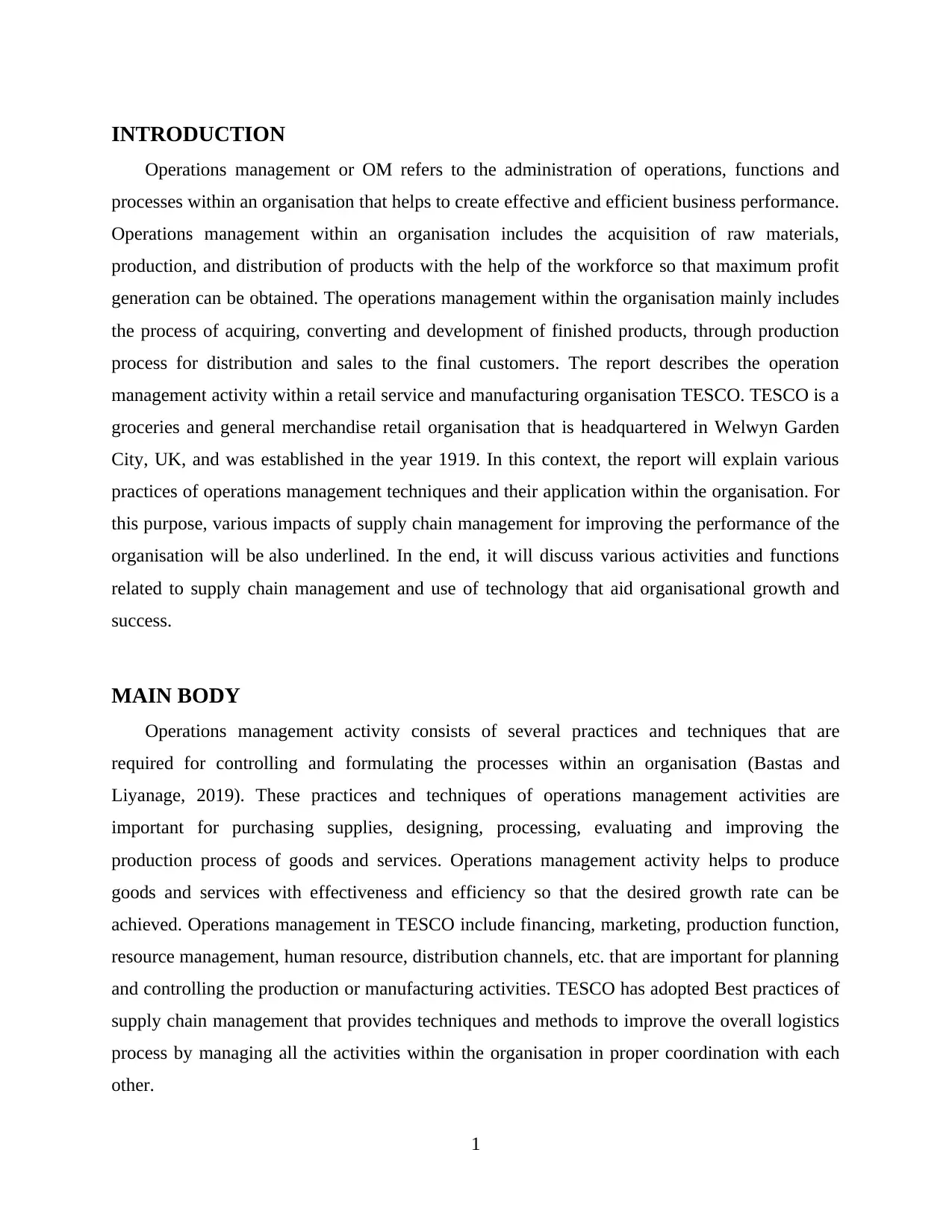
INTRODUCTION
Operations management or OM refers to the administration of operations, functions and
processes within an organisation that helps to create effective and efficient business performance.
Operations management within an organisation includes the acquisition of raw materials,
production, and distribution of products with the help of the workforce so that maximum profit
generation can be obtained. The operations management within the organisation mainly includes
the process of acquiring, converting and development of finished products, through production
process for distribution and sales to the final customers. The report describes the operation
management activity within a retail service and manufacturing organisation TESCO. TESCO is a
groceries and general merchandise retail organisation that is headquartered in Welwyn Garden
City, UK, and was established in the year 1919. In this context, the report will explain various
practices of operations management techniques and their application within the organisation. For
this purpose, various impacts of supply chain management for improving the performance of the
organisation will be also underlined. In the end, it will discuss various activities and functions
related to supply chain management and use of technology that aid organisational growth and
success.
MAIN BODY
Operations management activity consists of several practices and techniques that are
required for controlling and formulating the processes within an organisation (Bastas and
Liyanage, 2019). These practices and techniques of operations management activities are
important for purchasing supplies, designing, processing, evaluating and improving the
production process of goods and services. Operations management activity helps to produce
goods and services with effectiveness and efficiency so that the desired growth rate can be
achieved. Operations management in TESCO include financing, marketing, production function,
resource management, human resource, distribution channels, etc. that are important for planning
and controlling the production or manufacturing activities. TESCO has adopted Best practices of
supply chain management that provides techniques and methods to improve the overall logistics
process by managing all the activities within the organisation in proper coordination with each
other.
1
Operations management or OM refers to the administration of operations, functions and
processes within an organisation that helps to create effective and efficient business performance.
Operations management within an organisation includes the acquisition of raw materials,
production, and distribution of products with the help of the workforce so that maximum profit
generation can be obtained. The operations management within the organisation mainly includes
the process of acquiring, converting and development of finished products, through production
process for distribution and sales to the final customers. The report describes the operation
management activity within a retail service and manufacturing organisation TESCO. TESCO is a
groceries and general merchandise retail organisation that is headquartered in Welwyn Garden
City, UK, and was established in the year 1919. In this context, the report will explain various
practices of operations management techniques and their application within the organisation. For
this purpose, various impacts of supply chain management for improving the performance of the
organisation will be also underlined. In the end, it will discuss various activities and functions
related to supply chain management and use of technology that aid organisational growth and
success.
MAIN BODY
Operations management activity consists of several practices and techniques that are
required for controlling and formulating the processes within an organisation (Bastas and
Liyanage, 2019). These practices and techniques of operations management activities are
important for purchasing supplies, designing, processing, evaluating and improving the
production process of goods and services. Operations management activity helps to produce
goods and services with effectiveness and efficiency so that the desired growth rate can be
achieved. Operations management in TESCO include financing, marketing, production function,
resource management, human resource, distribution channels, etc. that are important for planning
and controlling the production or manufacturing activities. TESCO has adopted Best practices of
supply chain management that provides techniques and methods to improve the overall logistics
process by managing all the activities within the organisation in proper coordination with each
other.
1
⊘ This is a preview!⊘
Do you want full access?
Subscribe today to unlock all pages.

Trusted by 1+ million students worldwide
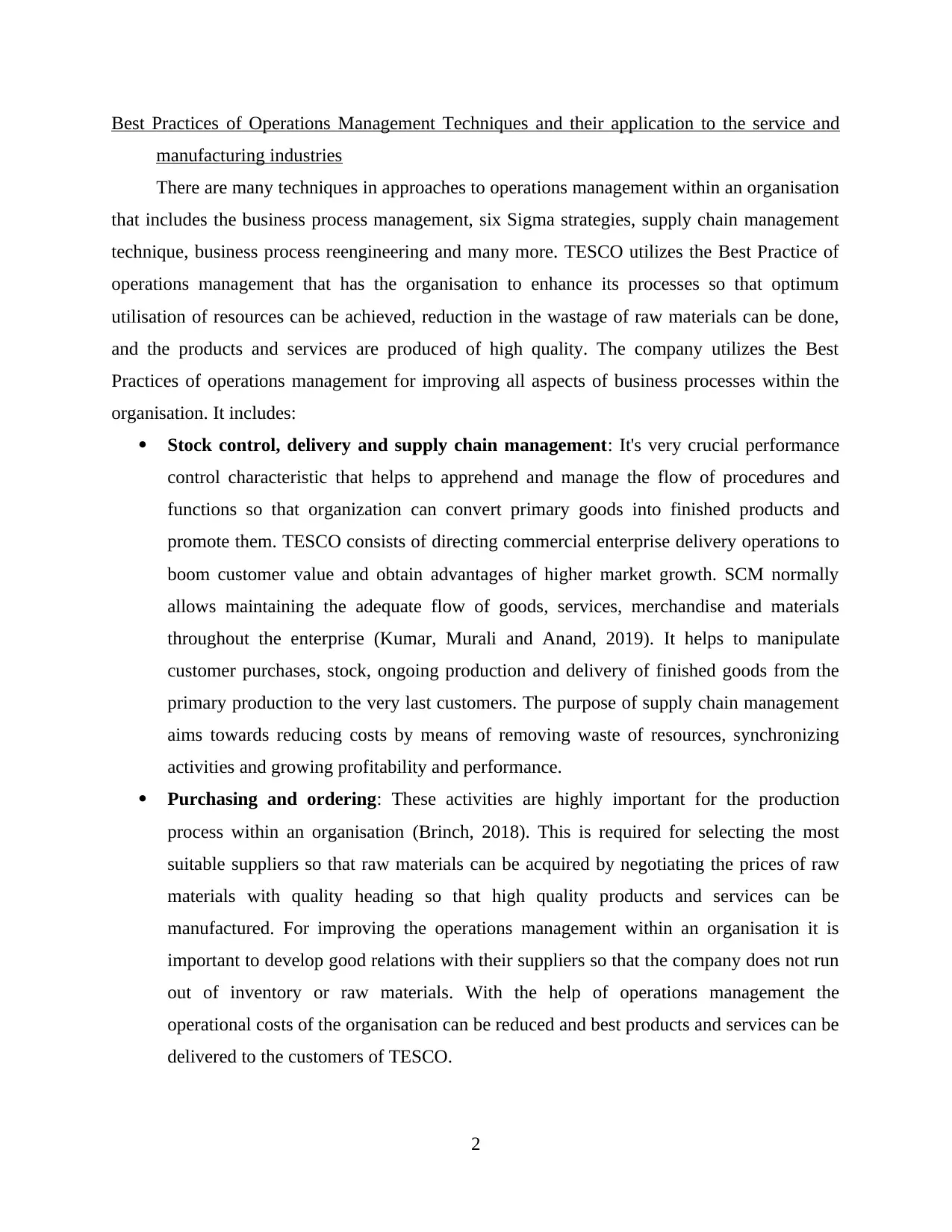
Best Practices of Operations Management Techniques and their application to the service and
manufacturing industries
There are many techniques in approaches to operations management within an organisation
that includes the business process management, six Sigma strategies, supply chain management
technique, business process reengineering and many more. TESCO utilizes the Best Practice of
operations management that has the organisation to enhance its processes so that optimum
utilisation of resources can be achieved, reduction in the wastage of raw materials can be done,
and the products and services are produced of high quality. The company utilizes the Best
Practices of operations management for improving all aspects of business processes within the
organisation. It includes:
Stock control, delivery and supply chain management: It's very crucial performance
control characteristic that helps to apprehend and manage the flow of procedures and
functions so that organization can convert primary goods into finished products and
promote them. TESCO consists of directing commercial enterprise delivery operations to
boom customer value and obtain advantages of higher market growth. SCM normally
allows maintaining the adequate flow of goods, services, merchandise and materials
throughout the enterprise (Kumar, Murali and Anand, 2019). It helps to manipulate
customer purchases, stock, ongoing production and delivery of finished goods from the
primary production to the very last customers. The purpose of supply chain management
aims towards reducing costs by means of removing waste of resources, synchronizing
activities and growing profitability and performance.
Purchasing and ordering: These activities are highly important for the production
process within an organisation (Brinch, 2018). This is required for selecting the most
suitable suppliers so that raw materials can be acquired by negotiating the prices of raw
materials with quality heading so that high quality products and services can be
manufactured. For improving the operations management within an organisation it is
important to develop good relations with their suppliers so that the company does not run
out of inventory or raw materials. With the help of operations management the
operational costs of the organisation can be reduced and best products and services can be
delivered to the customers of TESCO.
2
manufacturing industries
There are many techniques in approaches to operations management within an organisation
that includes the business process management, six Sigma strategies, supply chain management
technique, business process reengineering and many more. TESCO utilizes the Best Practice of
operations management that has the organisation to enhance its processes so that optimum
utilisation of resources can be achieved, reduction in the wastage of raw materials can be done,
and the products and services are produced of high quality. The company utilizes the Best
Practices of operations management for improving all aspects of business processes within the
organisation. It includes:
Stock control, delivery and supply chain management: It's very crucial performance
control characteristic that helps to apprehend and manage the flow of procedures and
functions so that organization can convert primary goods into finished products and
promote them. TESCO consists of directing commercial enterprise delivery operations to
boom customer value and obtain advantages of higher market growth. SCM normally
allows maintaining the adequate flow of goods, services, merchandise and materials
throughout the enterprise (Kumar, Murali and Anand, 2019). It helps to manipulate
customer purchases, stock, ongoing production and delivery of finished goods from the
primary production to the very last customers. The purpose of supply chain management
aims towards reducing costs by means of removing waste of resources, synchronizing
activities and growing profitability and performance.
Purchasing and ordering: These activities are highly important for the production
process within an organisation (Brinch, 2018). This is required for selecting the most
suitable suppliers so that raw materials can be acquired by negotiating the prices of raw
materials with quality heading so that high quality products and services can be
manufactured. For improving the operations management within an organisation it is
important to develop good relations with their suppliers so that the company does not run
out of inventory or raw materials. With the help of operations management the
operational costs of the organisation can be reduced and best products and services can be
delivered to the customers of TESCO.
2
Paraphrase This Document
Need a fresh take? Get an instant paraphrase of this document with our AI Paraphraser
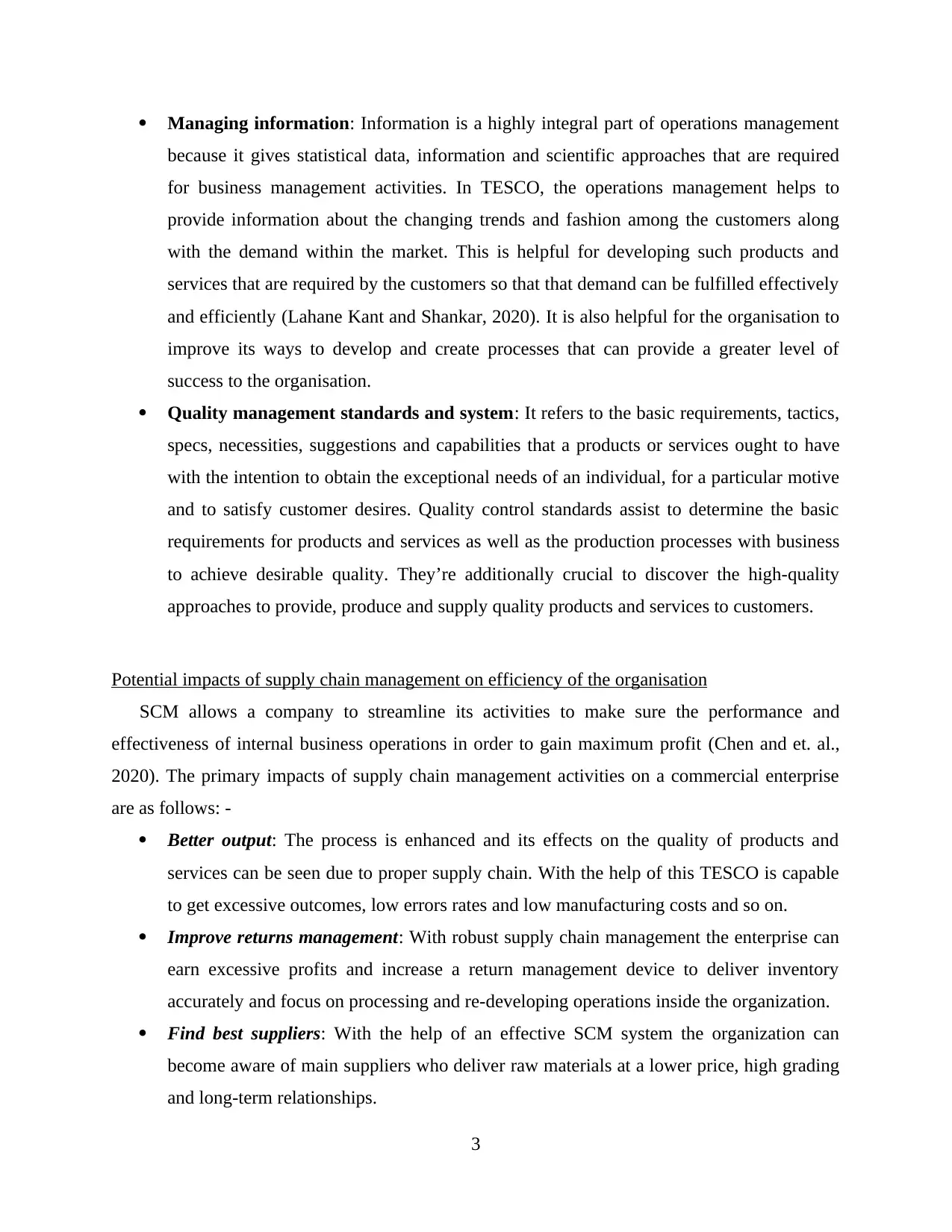
Managing information: Information is a highly integral part of operations management
because it gives statistical data, information and scientific approaches that are required
for business management activities. In TESCO, the operations management helps to
provide information about the changing trends and fashion among the customers along
with the demand within the market. This is helpful for developing such products and
services that are required by the customers so that that demand can be fulfilled effectively
and efficiently (Lahane Kant and Shankar, 2020). It is also helpful for the organisation to
improve its ways to develop and create processes that can provide a greater level of
success to the organisation.
Quality management standards and system: It refers to the basic requirements, tactics,
specs, necessities, suggestions and capabilities that a products or services ought to have
with the intention to obtain the exceptional needs of an individual, for a particular motive
and to satisfy customer desires. Quality control standards assist to determine the basic
requirements for products and services as well as the production processes with business
to achieve desirable quality. They’re additionally crucial to discover the high-quality
approaches to provide, produce and supply quality products and services to customers.
Potential impacts of supply chain management on efficiency of the organisation
SCM allows a company to streamline its activities to make sure the performance and
effectiveness of internal business operations in order to gain maximum profit (Chen and et. al.,
2020). The primary impacts of supply chain management activities on a commercial enterprise
are as follows: -
Better output: The process is enhanced and its effects on the quality of products and
services can be seen due to proper supply chain. With the help of this TESCO is capable
to get excessive outcomes, low errors rates and low manufacturing costs and so on.
Improve returns management: With robust supply chain management the enterprise can
earn excessive profits and increase a return management device to deliver inventory
accurately and focus on processing and re-developing operations inside the organization.
Find best suppliers: With the help of an effective SCM system the organization can
become aware of main suppliers who deliver raw materials at a lower price, high grading
and long-term relationships.
3
because it gives statistical data, information and scientific approaches that are required
for business management activities. In TESCO, the operations management helps to
provide information about the changing trends and fashion among the customers along
with the demand within the market. This is helpful for developing such products and
services that are required by the customers so that that demand can be fulfilled effectively
and efficiently (Lahane Kant and Shankar, 2020). It is also helpful for the organisation to
improve its ways to develop and create processes that can provide a greater level of
success to the organisation.
Quality management standards and system: It refers to the basic requirements, tactics,
specs, necessities, suggestions and capabilities that a products or services ought to have
with the intention to obtain the exceptional needs of an individual, for a particular motive
and to satisfy customer desires. Quality control standards assist to determine the basic
requirements for products and services as well as the production processes with business
to achieve desirable quality. They’re additionally crucial to discover the high-quality
approaches to provide, produce and supply quality products and services to customers.
Potential impacts of supply chain management on efficiency of the organisation
SCM allows a company to streamline its activities to make sure the performance and
effectiveness of internal business operations in order to gain maximum profit (Chen and et. al.,
2020). The primary impacts of supply chain management activities on a commercial enterprise
are as follows: -
Better output: The process is enhanced and its effects on the quality of products and
services can be seen due to proper supply chain. With the help of this TESCO is capable
to get excessive outcomes, low errors rates and low manufacturing costs and so on.
Improve returns management: With robust supply chain management the enterprise can
earn excessive profits and increase a return management device to deliver inventory
accurately and focus on processing and re-developing operations inside the organization.
Find best suppliers: With the help of an effective SCM system the organization can
become aware of main suppliers who deliver raw materials at a lower price, high grading
and long-term relationships.
3
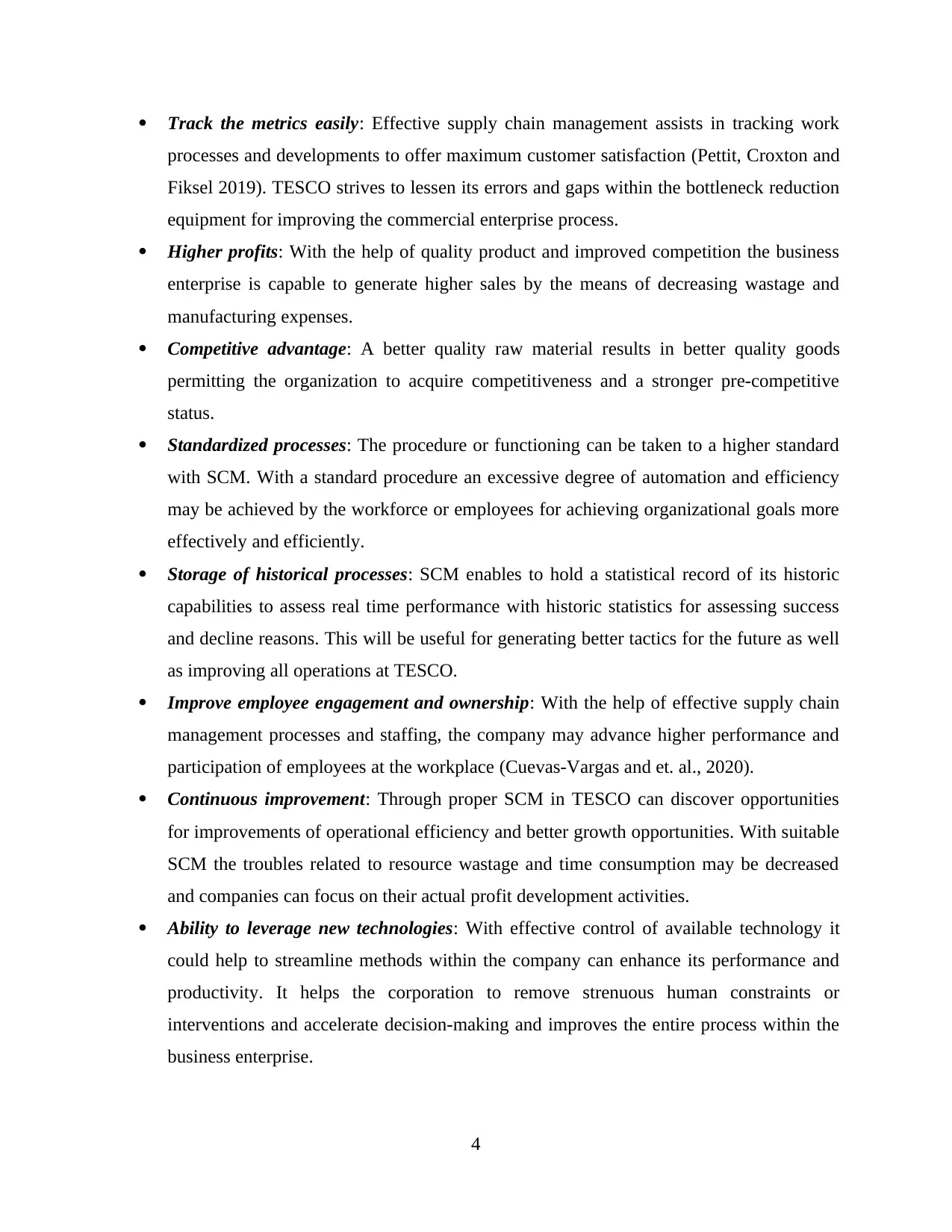
Track the metrics easily: Effective supply chain management assists in tracking work
processes and developments to offer maximum customer satisfaction (Pettit, Croxton and
Fiksel 2019). TESCO strives to lessen its errors and gaps within the bottleneck reduction
equipment for improving the commercial enterprise process.
Higher profits: With the help of quality product and improved competition the business
enterprise is capable to generate higher sales by the means of decreasing wastage and
manufacturing expenses.
Competitive advantage: A better quality raw material results in better quality goods
permitting the organization to acquire competitiveness and a stronger pre-competitive
status.
Standardized processes: The procedure or functioning can be taken to a higher standard
with SCM. With a standard procedure an excessive degree of automation and efficiency
may be achieved by the workforce or employees for achieving organizational goals more
effectively and efficiently.
Storage of historical processes: SCM enables to hold a statistical record of its historic
capabilities to assess real time performance with historic statistics for assessing success
and decline reasons. This will be useful for generating better tactics for the future as well
as improving all operations at TESCO.
Improve employee engagement and ownership: With the help of effective supply chain
management processes and staffing, the company may advance higher performance and
participation of employees at the workplace (Cuevas-Vargas and et. al., 2020).
Continuous improvement: Through proper SCM in TESCO can discover opportunities
for improvements of operational efficiency and better growth opportunities. With suitable
SCM the troubles related to resource wastage and time consumption may be decreased
and companies can focus on their actual profit development activities.
Ability to leverage new technologies: With effective control of available technology it
could help to streamline methods within the company can enhance its performance and
productivity. It helps the corporation to remove strenuous human constraints or
interventions and accelerate decision-making and improves the entire process within the
business enterprise.
4
processes and developments to offer maximum customer satisfaction (Pettit, Croxton and
Fiksel 2019). TESCO strives to lessen its errors and gaps within the bottleneck reduction
equipment for improving the commercial enterprise process.
Higher profits: With the help of quality product and improved competition the business
enterprise is capable to generate higher sales by the means of decreasing wastage and
manufacturing expenses.
Competitive advantage: A better quality raw material results in better quality goods
permitting the organization to acquire competitiveness and a stronger pre-competitive
status.
Standardized processes: The procedure or functioning can be taken to a higher standard
with SCM. With a standard procedure an excessive degree of automation and efficiency
may be achieved by the workforce or employees for achieving organizational goals more
effectively and efficiently.
Storage of historical processes: SCM enables to hold a statistical record of its historic
capabilities to assess real time performance with historic statistics for assessing success
and decline reasons. This will be useful for generating better tactics for the future as well
as improving all operations at TESCO.
Improve employee engagement and ownership: With the help of effective supply chain
management processes and staffing, the company may advance higher performance and
participation of employees at the workplace (Cuevas-Vargas and et. al., 2020).
Continuous improvement: Through proper SCM in TESCO can discover opportunities
for improvements of operational efficiency and better growth opportunities. With suitable
SCM the troubles related to resource wastage and time consumption may be decreased
and companies can focus on their actual profit development activities.
Ability to leverage new technologies: With effective control of available technology it
could help to streamline methods within the company can enhance its performance and
productivity. It helps the corporation to remove strenuous human constraints or
interventions and accelerate decision-making and improves the entire process within the
business enterprise.
4
⊘ This is a preview!⊘
Do you want full access?
Subscribe today to unlock all pages.

Trusted by 1+ million students worldwide
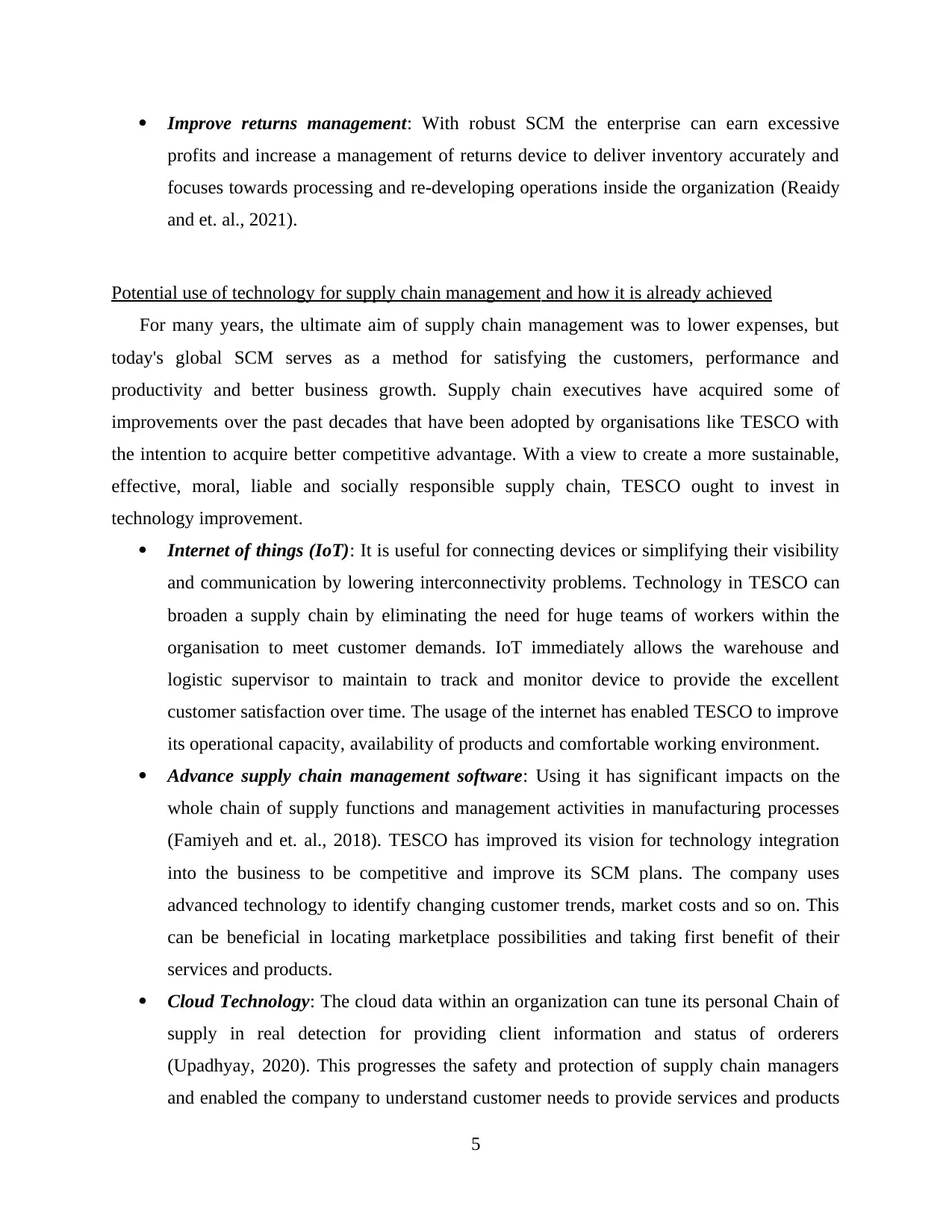
Improve returns management: With robust SCM the enterprise can earn excessive
profits and increase a management of returns device to deliver inventory accurately and
focuses towards processing and re-developing operations inside the organization (Reaidy
and et. al., 2021).
Potential use of technology for supply chain management and how it is already achieved
For many years, the ultimate aim of supply chain management was to lower expenses, but
today's global SCM serves as a method for satisfying the customers, performance and
productivity and better business growth. Supply chain executives have acquired some of
improvements over the past decades that have been adopted by organisations like TESCO with
the intention to acquire better competitive advantage. With a view to create a more sustainable,
effective, moral, liable and socially responsible supply chain, TESCO ought to invest in
technology improvement.
Internet of things (IoT): It is useful for connecting devices or simplifying their visibility
and communication by lowering interconnectivity problems. Technology in TESCO can
broaden a supply chain by eliminating the need for huge teams of workers within the
organisation to meet customer demands. IoT immediately allows the warehouse and
logistic supervisor to maintain to track and monitor device to provide the excellent
customer satisfaction over time. The usage of the internet has enabled TESCO to improve
its operational capacity, availability of products and comfortable working environment.
Advance supply chain management software: Using it has significant impacts on the
whole chain of supply functions and management activities in manufacturing processes
(Famiyeh and et. al., 2018). TESCO has improved its vision for technology integration
into the business to be competitive and improve its SCM plans. The company uses
advanced technology to identify changing customer trends, market costs and so on. This
can be beneficial in locating marketplace possibilities and taking first benefit of their
services and products.
Cloud Technology: The cloud data within an organization can tune its personal Chain of
supply in real detection for providing client information and status of orderers
(Upadhyay, 2020). This progresses the safety and protection of supply chain managers
and enabled the company to understand customer needs to provide services and products
5
profits and increase a management of returns device to deliver inventory accurately and
focuses towards processing and re-developing operations inside the organization (Reaidy
and et. al., 2021).
Potential use of technology for supply chain management and how it is already achieved
For many years, the ultimate aim of supply chain management was to lower expenses, but
today's global SCM serves as a method for satisfying the customers, performance and
productivity and better business growth. Supply chain executives have acquired some of
improvements over the past decades that have been adopted by organisations like TESCO with
the intention to acquire better competitive advantage. With a view to create a more sustainable,
effective, moral, liable and socially responsible supply chain, TESCO ought to invest in
technology improvement.
Internet of things (IoT): It is useful for connecting devices or simplifying their visibility
and communication by lowering interconnectivity problems. Technology in TESCO can
broaden a supply chain by eliminating the need for huge teams of workers within the
organisation to meet customer demands. IoT immediately allows the warehouse and
logistic supervisor to maintain to track and monitor device to provide the excellent
customer satisfaction over time. The usage of the internet has enabled TESCO to improve
its operational capacity, availability of products and comfortable working environment.
Advance supply chain management software: Using it has significant impacts on the
whole chain of supply functions and management activities in manufacturing processes
(Famiyeh and et. al., 2018). TESCO has improved its vision for technology integration
into the business to be competitive and improve its SCM plans. The company uses
advanced technology to identify changing customer trends, market costs and so on. This
can be beneficial in locating marketplace possibilities and taking first benefit of their
services and products.
Cloud Technology: The cloud data within an organization can tune its personal Chain of
supply in real detection for providing client information and status of orderers
(Upadhyay, 2020). This progresses the safety and protection of supply chain managers
and enabled the company to understand customer needs to provide services and products
5
Paraphrase This Document
Need a fresh take? Get an instant paraphrase of this document with our AI Paraphraser
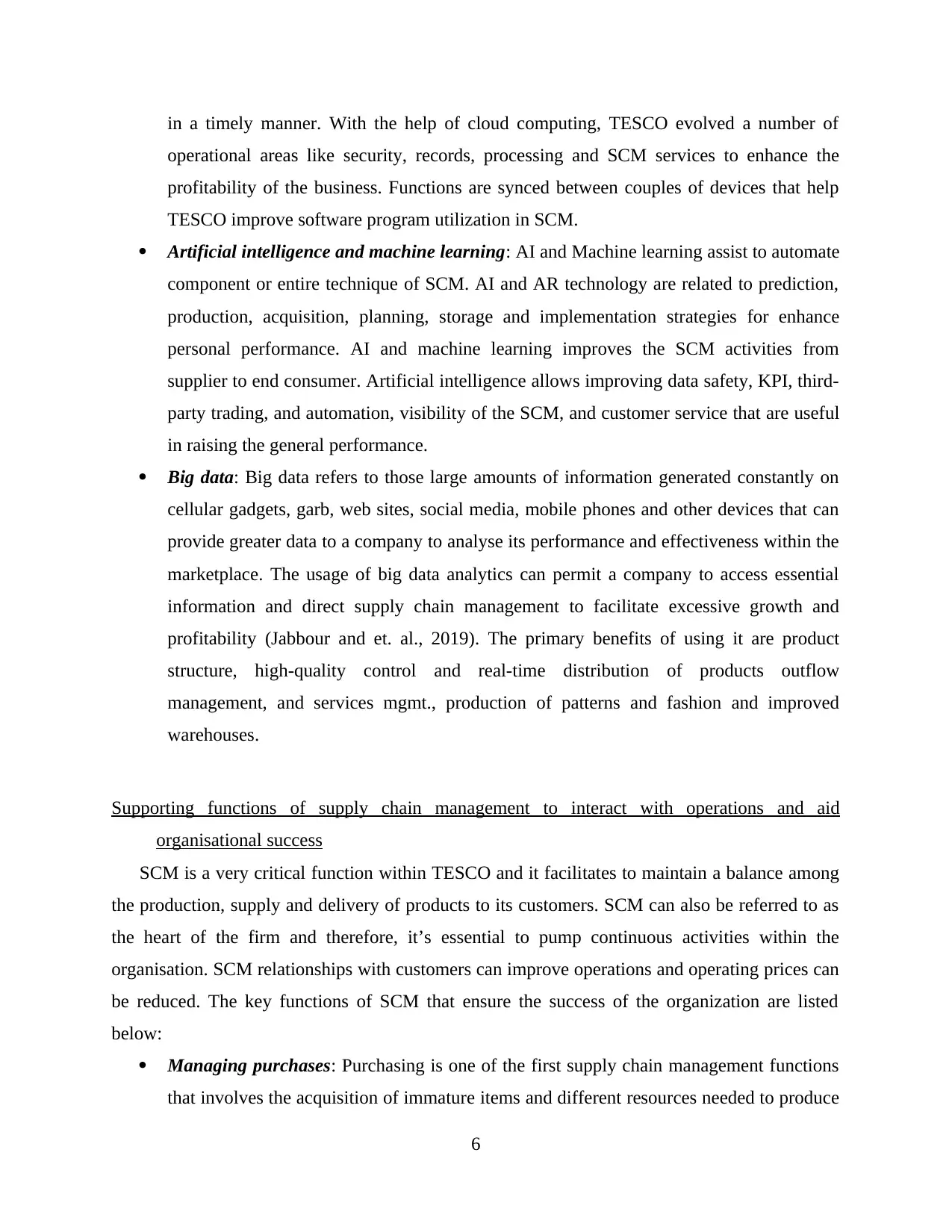
in a timely manner. With the help of cloud computing, TESCO evolved a number of
operational areas like security, records, processing and SCM services to enhance the
profitability of the business. Functions are synced between couples of devices that help
TESCO improve software program utilization in SCM.
Artificial intelligence and machine learning: AI and Machine learning assist to automate
component or entire technique of SCM. AI and AR technology are related to prediction,
production, acquisition, planning, storage and implementation strategies for enhance
personal performance. AI and machine learning improves the SCM activities from
supplier to end consumer. Artificial intelligence allows improving data safety, KPI, third-
party trading, and automation, visibility of the SCM, and customer service that are useful
in raising the general performance.
Big data: Big data refers to those large amounts of information generated constantly on
cellular gadgets, garb, web sites, social media, mobile phones and other devices that can
provide greater data to a company to analyse its performance and effectiveness within the
marketplace. The usage of big data analytics can permit a company to access essential
information and direct supply chain management to facilitate excessive growth and
profitability (Jabbour and et. al., 2019). The primary benefits of using it are product
structure, high-quality control and real-time distribution of products outflow
management, and services mgmt., production of patterns and fashion and improved
warehouses.
Supporting functions of supply chain management to interact with operations and aid
organisational success
SCM is a very critical function within TESCO and it facilitates to maintain a balance among
the production, supply and delivery of products to its customers. SCM can also be referred to as
the heart of the firm and therefore, it’s essential to pump continuous activities within the
organisation. SCM relationships with customers can improve operations and operating prices can
be reduced. The key functions of SCM that ensure the success of the organization are listed
below:
Managing purchases: Purchasing is one of the first supply chain management functions
that involves the acquisition of immature items and different resources needed to produce
6
operational areas like security, records, processing and SCM services to enhance the
profitability of the business. Functions are synced between couples of devices that help
TESCO improve software program utilization in SCM.
Artificial intelligence and machine learning: AI and Machine learning assist to automate
component or entire technique of SCM. AI and AR technology are related to prediction,
production, acquisition, planning, storage and implementation strategies for enhance
personal performance. AI and machine learning improves the SCM activities from
supplier to end consumer. Artificial intelligence allows improving data safety, KPI, third-
party trading, and automation, visibility of the SCM, and customer service that are useful
in raising the general performance.
Big data: Big data refers to those large amounts of information generated constantly on
cellular gadgets, garb, web sites, social media, mobile phones and other devices that can
provide greater data to a company to analyse its performance and effectiveness within the
marketplace. The usage of big data analytics can permit a company to access essential
information and direct supply chain management to facilitate excessive growth and
profitability (Jabbour and et. al., 2019). The primary benefits of using it are product
structure, high-quality control and real-time distribution of products outflow
management, and services mgmt., production of patterns and fashion and improved
warehouses.
Supporting functions of supply chain management to interact with operations and aid
organisational success
SCM is a very critical function within TESCO and it facilitates to maintain a balance among
the production, supply and delivery of products to its customers. SCM can also be referred to as
the heart of the firm and therefore, it’s essential to pump continuous activities within the
organisation. SCM relationships with customers can improve operations and operating prices can
be reduced. The key functions of SCM that ensure the success of the organization are listed
below:
Managing purchases: Purchasing is one of the first supply chain management functions
that involves the acquisition of immature items and different resources needed to produce
6
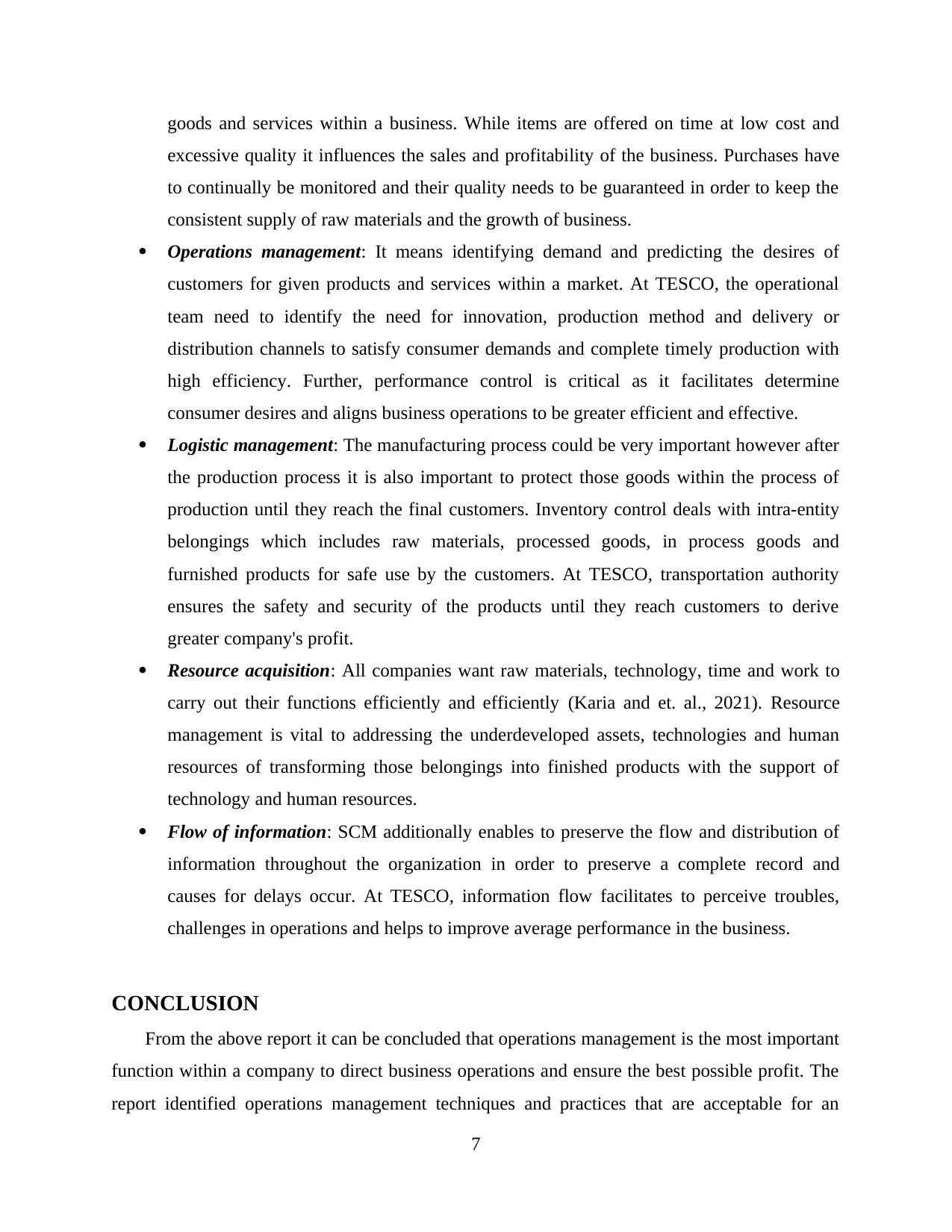
goods and services within a business. While items are offered on time at low cost and
excessive quality it influences the sales and profitability of the business. Purchases have
to continually be monitored and their quality needs to be guaranteed in order to keep the
consistent supply of raw materials and the growth of business.
Operations management: It means identifying demand and predicting the desires of
customers for given products and services within a market. At TESCO, the operational
team need to identify the need for innovation, production method and delivery or
distribution channels to satisfy consumer demands and complete timely production with
high efficiency. Further, performance control is critical as it facilitates determine
consumer desires and aligns business operations to be greater efficient and effective.
Logistic management: The manufacturing process could be very important however after
the production process it is also important to protect those goods within the process of
production until they reach the final customers. Inventory control deals with intra-entity
belongings which includes raw materials, processed goods, in process goods and
furnished products for safe use by the customers. At TESCO, transportation authority
ensures the safety and security of the products until they reach customers to derive
greater company's profit.
Resource acquisition: All companies want raw materials, technology, time and work to
carry out their functions efficiently and efficiently (Karia and et. al., 2021). Resource
management is vital to addressing the underdeveloped assets, technologies and human
resources of transforming those belongings into finished products with the support of
technology and human resources.
Flow of information: SCM additionally enables to preserve the flow and distribution of
information throughout the organization in order to preserve a complete record and
causes for delays occur. At TESCO, information flow facilitates to perceive troubles,
challenges in operations and helps to improve average performance in the business.
CONCLUSION
From the above report it can be concluded that operations management is the most important
function within a company to direct business operations and ensure the best possible profit. The
report identified operations management techniques and practices that are acceptable for an
7
excessive quality it influences the sales and profitability of the business. Purchases have
to continually be monitored and their quality needs to be guaranteed in order to keep the
consistent supply of raw materials and the growth of business.
Operations management: It means identifying demand and predicting the desires of
customers for given products and services within a market. At TESCO, the operational
team need to identify the need for innovation, production method and delivery or
distribution channels to satisfy consumer demands and complete timely production with
high efficiency. Further, performance control is critical as it facilitates determine
consumer desires and aligns business operations to be greater efficient and effective.
Logistic management: The manufacturing process could be very important however after
the production process it is also important to protect those goods within the process of
production until they reach the final customers. Inventory control deals with intra-entity
belongings which includes raw materials, processed goods, in process goods and
furnished products for safe use by the customers. At TESCO, transportation authority
ensures the safety and security of the products until they reach customers to derive
greater company's profit.
Resource acquisition: All companies want raw materials, technology, time and work to
carry out their functions efficiently and efficiently (Karia and et. al., 2021). Resource
management is vital to addressing the underdeveloped assets, technologies and human
resources of transforming those belongings into finished products with the support of
technology and human resources.
Flow of information: SCM additionally enables to preserve the flow and distribution of
information throughout the organization in order to preserve a complete record and
causes for delays occur. At TESCO, information flow facilitates to perceive troubles,
challenges in operations and helps to improve average performance in the business.
CONCLUSION
From the above report it can be concluded that operations management is the most important
function within a company to direct business operations and ensure the best possible profit. The
report identified operations management techniques and practices that are acceptable for an
7
⊘ This is a preview!⊘
Do you want full access?
Subscribe today to unlock all pages.

Trusted by 1+ million students worldwide
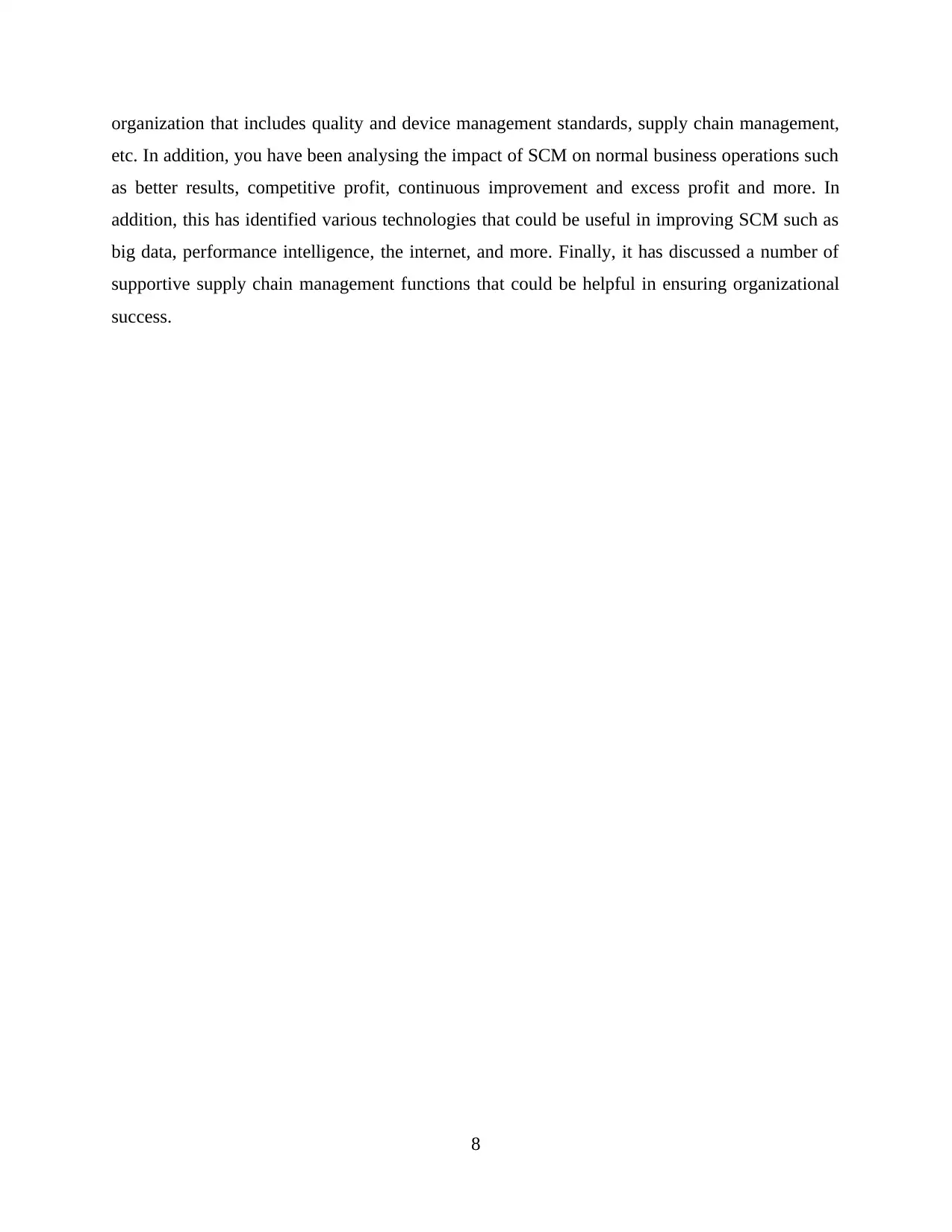
organization that includes quality and device management standards, supply chain management,
etc. In addition, you have been analysing the impact of SCM on normal business operations such
as better results, competitive profit, continuous improvement and excess profit and more. In
addition, this has identified various technologies that could be useful in improving SCM such as
big data, performance intelligence, the internet, and more. Finally, it has discussed a number of
supportive supply chain management functions that could be helpful in ensuring organizational
success.
8
etc. In addition, you have been analysing the impact of SCM on normal business operations such
as better results, competitive profit, continuous improvement and excess profit and more. In
addition, this has identified various technologies that could be useful in improving SCM such as
big data, performance intelligence, the internet, and more. Finally, it has discussed a number of
supportive supply chain management functions that could be helpful in ensuring organizational
success.
8
Paraphrase This Document
Need a fresh take? Get an instant paraphrase of this document with our AI Paraphraser
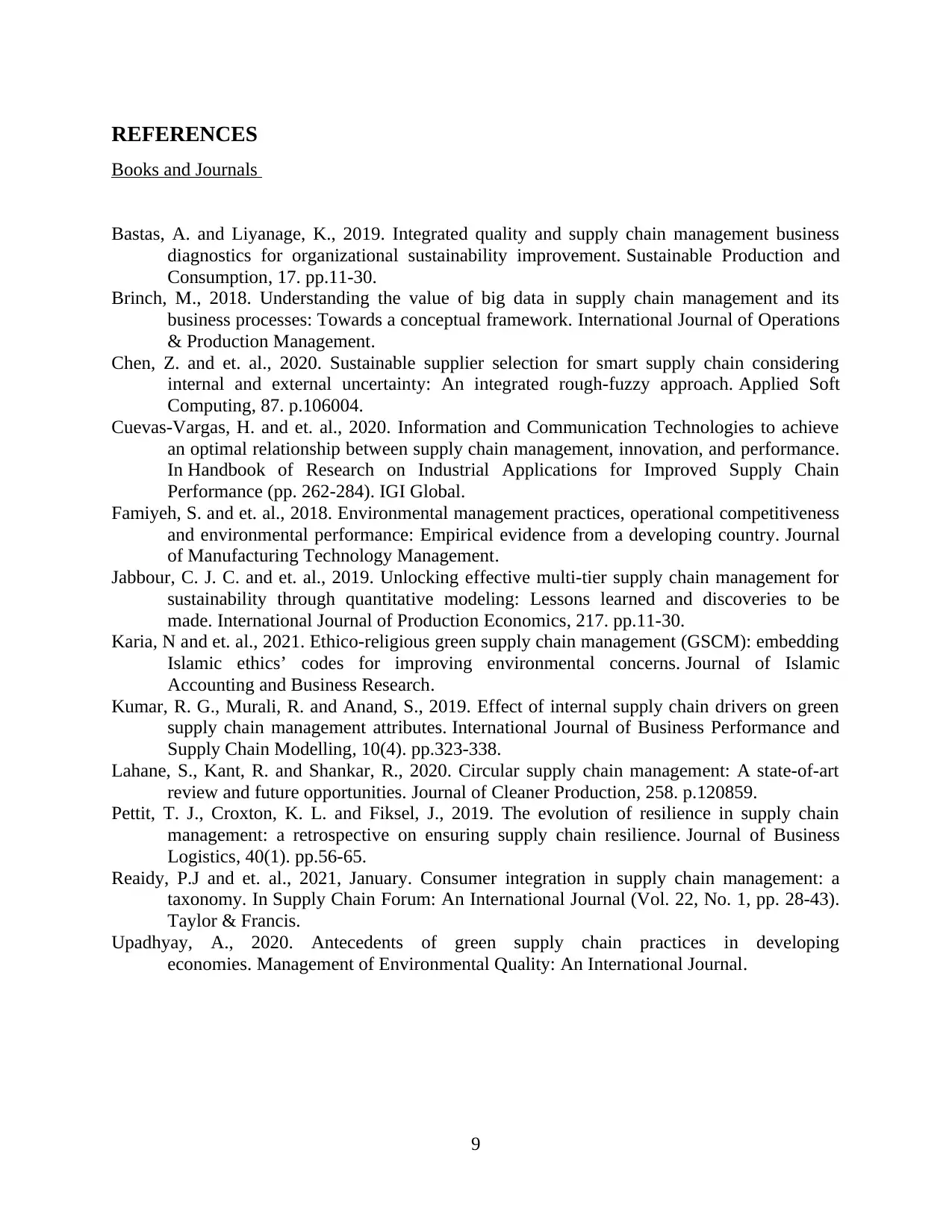
REFERENCES
Books and Journals
Bastas, A. and Liyanage, K., 2019. Integrated quality and supply chain management business
diagnostics for organizational sustainability improvement. Sustainable Production and
Consumption, 17. pp.11-30.
Brinch, M., 2018. Understanding the value of big data in supply chain management and its
business processes: Towards a conceptual framework. International Journal of Operations
& Production Management.
Chen, Z. and et. al., 2020. Sustainable supplier selection for smart supply chain considering
internal and external uncertainty: An integrated rough-fuzzy approach. Applied Soft
Computing, 87. p.106004.
Cuevas-Vargas, H. and et. al., 2020. Information and Communication Technologies to achieve
an optimal relationship between supply chain management, innovation, and performance.
In Handbook of Research on Industrial Applications for Improved Supply Chain
Performance (pp. 262-284). IGI Global.
Famiyeh, S. and et. al., 2018. Environmental management practices, operational competitiveness
and environmental performance: Empirical evidence from a developing country. Journal
of Manufacturing Technology Management.
Jabbour, C. J. C. and et. al., 2019. Unlocking effective multi-tier supply chain management for
sustainability through quantitative modeling: Lessons learned and discoveries to be
made. International Journal of Production Economics, 217. pp.11-30.
Karia, N and et. al., 2021. Ethico-religious green supply chain management (GSCM): embedding
Islamic ethics’ codes for improving environmental concerns. Journal of Islamic
Accounting and Business Research.
Kumar, R. G., Murali, R. and Anand, S., 2019. Effect of internal supply chain drivers on green
supply chain management attributes. International Journal of Business Performance and
Supply Chain Modelling, 10(4). pp.323-338.
Lahane, S., Kant, R. and Shankar, R., 2020. Circular supply chain management: A state-of-art
review and future opportunities. Journal of Cleaner Production, 258. p.120859.
Pettit, T. J., Croxton, K. L. and Fiksel, J., 2019. The evolution of resilience in supply chain
management: a retrospective on ensuring supply chain resilience. Journal of Business
Logistics, 40(1). pp.56-65.
Reaidy, P.J and et. al., 2021, January. Consumer integration in supply chain management: a
taxonomy. In Supply Chain Forum: An International Journal (Vol. 22, No. 1, pp. 28-43).
Taylor & Francis.
Upadhyay, A., 2020. Antecedents of green supply chain practices in developing
economies. Management of Environmental Quality: An International Journal.
9
Books and Journals
Bastas, A. and Liyanage, K., 2019. Integrated quality and supply chain management business
diagnostics for organizational sustainability improvement. Sustainable Production and
Consumption, 17. pp.11-30.
Brinch, M., 2018. Understanding the value of big data in supply chain management and its
business processes: Towards a conceptual framework. International Journal of Operations
& Production Management.
Chen, Z. and et. al., 2020. Sustainable supplier selection for smart supply chain considering
internal and external uncertainty: An integrated rough-fuzzy approach. Applied Soft
Computing, 87. p.106004.
Cuevas-Vargas, H. and et. al., 2020. Information and Communication Technologies to achieve
an optimal relationship between supply chain management, innovation, and performance.
In Handbook of Research on Industrial Applications for Improved Supply Chain
Performance (pp. 262-284). IGI Global.
Famiyeh, S. and et. al., 2018. Environmental management practices, operational competitiveness
and environmental performance: Empirical evidence from a developing country. Journal
of Manufacturing Technology Management.
Jabbour, C. J. C. and et. al., 2019. Unlocking effective multi-tier supply chain management for
sustainability through quantitative modeling: Lessons learned and discoveries to be
made. International Journal of Production Economics, 217. pp.11-30.
Karia, N and et. al., 2021. Ethico-religious green supply chain management (GSCM): embedding
Islamic ethics’ codes for improving environmental concerns. Journal of Islamic
Accounting and Business Research.
Kumar, R. G., Murali, R. and Anand, S., 2019. Effect of internal supply chain drivers on green
supply chain management attributes. International Journal of Business Performance and
Supply Chain Modelling, 10(4). pp.323-338.
Lahane, S., Kant, R. and Shankar, R., 2020. Circular supply chain management: A state-of-art
review and future opportunities. Journal of Cleaner Production, 258. p.120859.
Pettit, T. J., Croxton, K. L. and Fiksel, J., 2019. The evolution of resilience in supply chain
management: a retrospective on ensuring supply chain resilience. Journal of Business
Logistics, 40(1). pp.56-65.
Reaidy, P.J and et. al., 2021, January. Consumer integration in supply chain management: a
taxonomy. In Supply Chain Forum: An International Journal (Vol. 22, No. 1, pp. 28-43).
Taylor & Francis.
Upadhyay, A., 2020. Antecedents of green supply chain practices in developing
economies. Management of Environmental Quality: An International Journal.
9
1 out of 11
Related Documents
Your All-in-One AI-Powered Toolkit for Academic Success.
+13062052269
info@desklib.com
Available 24*7 on WhatsApp / Email
![[object Object]](/_next/static/media/star-bottom.7253800d.svg)
Unlock your academic potential
Copyright © 2020–2025 A2Z Services. All Rights Reserved. Developed and managed by ZUCOL.




